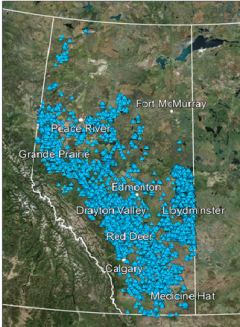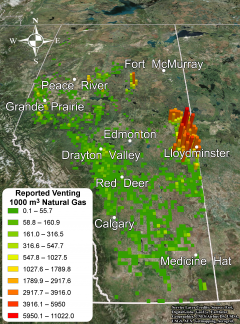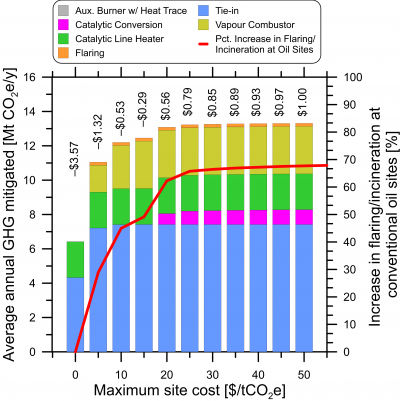A study published today by Carleton University’s David Tyner and Matthew Johnson in the prestigious journal Environmental Science and Technology reveals broad opportunities to mitigate methane emissions in Alberta’s oil and gas industry in a cost-effective way.

9422 oil sites in Alberta
Through detailed analysis of mitigation potential at nearly 10,000 individual sites, the study determined a 45-per-cent reduction in reported vented methane at upstream oil and heavy oil production sites – in line with federal and provincial targets — is economically efficient and feasible.
“There are up front capital costs to industry in the range of $150 million to $500 million depending on the scenario considered, but these are largely offset by revenue from capture of saleable gas into pipelines or reduced reliance on supplementary propane use at production sites,” said Tyner, a research associate at the Energy and Emissions Research Lab (EERL) within the Department of Mechanical and Aerospace Engineering. “The net average cost to industry is less than $2.50 per tonne CO2e and some sites could be profitable depending on the scenario considered.”
“Compared to federal and provincial carbon price targets of $30 to $50 per tonne, these actions are incredibly cheap,” added Johnson, a Canada Research Professor in Carleton’s Faculty of Engineering and Design and head of EERL. “They represent some of the most cost-effective actions available and show why governments are right to focus on near-term methane reductions as a key opportunity in battling climate change.”
“Given the potential returns, the initial capital costs would be better classed as an investment in the Canadian energy sector. Beyond the obvious environmental benefits, the economic spinoffs for engineering service providers and technology companies would be significant. This is an important opportunity for improving competitiveness and reducing the carbon footprint of Canadian energy development.”
The paper evaluated six types of mitigation methods, including recovery of gas into pipelines to sell, using gas for on-site process heating requirements, or disposal via combustion.

Reported venting volumes in Alberta in 2015
The paper notes there are other important sources of methane emissions in the oil and gas sector beyond those specifically considered in the analysis. However, the reduction opportunities at the selected sites exceed the nominal 45-per-cent reduction target and could partially offset the challenges of addressing methane emissions from fugitive and unreported venting sources.
The Carleton researchers also considered the implications of their widely cited, recently published airborne methane measurement study that suggested reported venting at heavy oil sites in Alberta is underestimated by as much as 4.9 times.
“There is a further silver lining in this research – the larger volumes of released methane suggested by field measurements actually improve the economics of mitigating the gas,” said Johnson. “The analysis suggests that with more methane available, sector-wide methane reductions of 34 per cent are economically achievable, even before considering other methane sources such as fugitive leaks and pneumatic venting,” added Tyner.
“These findings serve as a prime example of the leading research being performed every day at Carleton,” said Fred Afagh, interim dean of the Faculty of Engineering and Design. “Our researchers are continually developing real-world solutions that benefit our environment and society as a whole.”
A stark new report from the global scientific authority on climate change this month said governments must make “rapid, far-reaching and unprecedented changes in all aspects of society” to avoid disastrous levels of global warming.
 The report issued by the UN Intergovernmental Panel on Climate Change (IPCC), said the planet will reach the crucial threshold of 1.5 C above pre-industrial levels by as early as 2030 based on current levels of greenhouse gas emissions, precipitating the risk of extreme drought, wildfires, floods and food shortages for hundreds of millions of people.
The report issued by the UN Intergovernmental Panel on Climate Change (IPCC), said the planet will reach the crucial threshold of 1.5 C above pre-industrial levels by as early as 2030 based on current levels of greenhouse gas emissions, precipitating the risk of extreme drought, wildfires, floods and food shortages for hundreds of millions of people.
The planet is already two-thirds of the way there, with global temperatures having warmed about 1 C.
Canada would have to cut its emissions almost in half over the next 12 years to meet the stiffer targets dozens of international climate change experts say are required to prevent catastrophic results from global warming.